Every purchase you make online. Websites you visit. Accounts you open or post you share. This is the digital footprint that you leave behind with all of your devices whether you intended to or not. Why is a digital footprint important? Well, for starters, these online traces pose a risk to your privacy, but it’s so much more than that. Here’s a better explanation of what you need to know plus how to erase your digital footprint. Understanding why digital footprints matter is crucial in today’s digital age, as it emphasizes the importance of managing these footprints to control the data gathered about us.
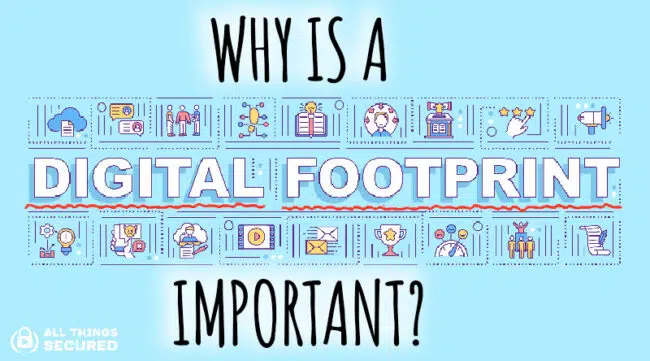
It’s important to understand digital footprints and how we can limit or erase our online data. It also helps to get a few examples of all the data and differentiate between passive vs active digital footprints.
The way we present ourselves online influences our offline reputation, so it’s worth being intentional about our digital footprint!
In our digital world, every little action we take leaves a trace behind. Even our legal existence as part of a government-run country means that some of our personal information is somewhere online.
A few examples of common digital footprints include the emails we send, websites we visit, products we purchase, online banking, newsletters we subscribe to and mobile apps that we use.
It also includes anything we post online, such as reviews, comments and even articles that we’ve written and published.
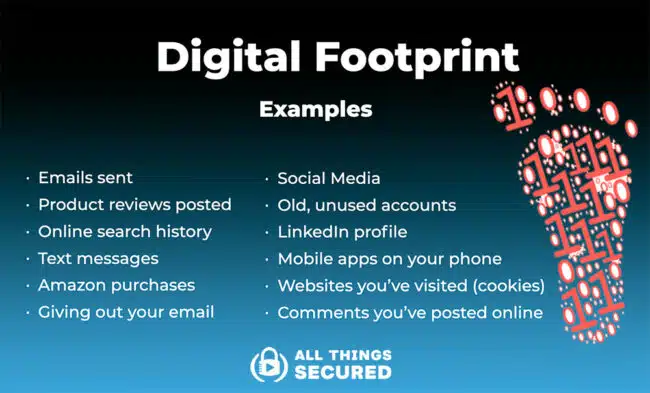
Everybody has a digital footprint. You have to explore what this looks like for you – there is no “digital footprint checker” to do this. The fact that you have one isn’t bad, but the problem is that most people don’t really care.
As with most things related to our privacy, the hazards of being irresponsible with your digital footprint only come to our attention after it’s too late.
Why does digital footprint matter? It matters because…
- It’s (mostly) permanent: With few exceptions, anything that makes it onto the internet is permanent. You can delete a Tweet, but there’s still a record of it somewhere. You can change a website post, but a snapshot has already been archived.
- It’s a reflection of you: Whether it’s a future employer, a future spouse or somebody else who is stalking you on social media, your digital footprint leaves a lasting impression that is hard to reverse.
- It makes you vulnerable: Your personal information (home address, email address, mobile phone number, etc.) can be used by criminals to take advantage of you or impersonate you.
So the answer to the question “Does digital footprint matter” is a resounding YES.
Is your digital footprint permanent? In some ways, especially those where the data is out of your control, it is. And that can be scary.
What’s even scarier is that we don’t always have control of our digital footprint. Most of the time we’re to blame for the personal information that gets published online, but it’s surprising how much of our digital footprint happens without our knowledge.
To understand how your personal data ends up floating around online, it’s important to differentiate between an active digital footprint and a passive one.
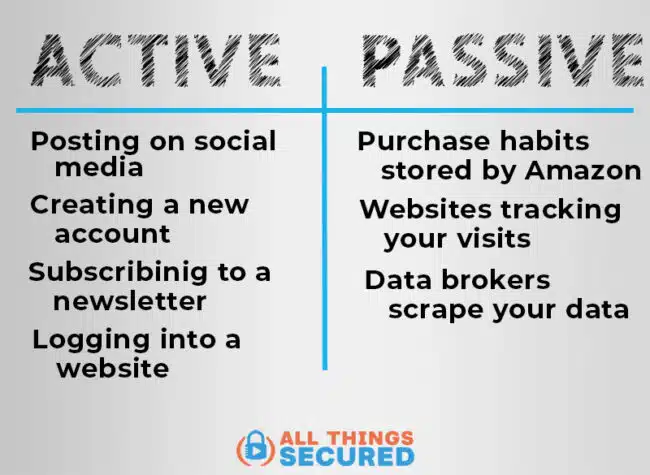
Active Digital Footprints
An active digital footprint is when we intentionally and knowingly share information online. Often this is voluntary, such as posting on social media, completing an online form such as subscribing to a newsletter, or giving up our email address to our favorite shopping site in exchange for a discount code.
Other times however, it is involuntary. For example, when engaging in online shopping to purchase something, you are required to provide a valid credit card number as well as your home address. This activity not only contributes to your digital footprint through the transaction itself but also through the personal information associated with it, showcasing the evolution of online shopping as part of the growing complexity of digital footprints over time.
It’s also quite common to see popups on websites you visit asking if you agree to accept cookies. Even the act of clicking the “accept” button is an active way that you build digital footprints.
Passive Digital Footprints
A passive digital footprint is one where information is either scraped off of public records or collected without your knowledge or consent.
Activities on social networking sites significantly contribute to the passive digital footprint by collecting data on user behavior without direct action from the users themselves. This information is then used by advertisers to create targeted content and profiles, further expanding the digital footprint without explicit consent.
Most people would be shocked and horrified to learn about the detailed profile that has been created by tech companies like Google or Facebook. Google’s analytics code is used by more than 50% of all websites, which means that the tech giant is able to track almost every move you make online.
This is especially true if your primary internet browser is Chrome!
You can also be tracked using your IP address, which is one reason why people use a virtual private network to mask their IP.
Managing Your Digital Reputation
So much of what we do on the internet has an impact on our real-life reputation. Our online activities impact how our friends see us and even the jobs we can get. Yet somehow we don’t take care with how we manage our online identity.
In the online world, you have the opportunity to leave a positive digital footprint as well as a negative digital footprint.
- Negative Digital Footprint: In this case, a negative footprint would be posting vicious comments on Facebook posts, biting product reviews or inappropriate jokes digitally. This could take place on public social media platforms or even a private messaging apps. Either way, we rarely understand how much harm this negativity can have on our reputation.
- Positive Digital Footprint: A positive digital footprint example, on the other hand, could be an article or blog post you’ve published, a personal bio on an about page or encouraging comments on social media sites.
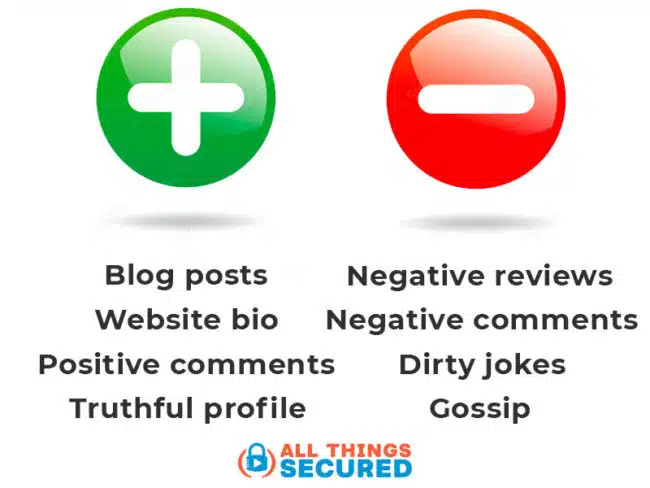
Managing your online reputation requires being intentional about limiting your negative interactions and increasing the positive online activities. And in some cases, it means finding ways to erase your digital footprint.
To protect your digital footprint, it’s crucial to adopt practices such as checking your digital presence regularly, reducing the sources that hold your personal information, adjusting privacy settings on social media, using secure connections, and avoiding oversharing personal details. These steps are fundamental in safeguarding your digital reputation and ensuring your online activities reflect positively on you.
How to Erase Your Digital Footprint
“Can a digital footprint be erased?”
Although it’s impossible to completely erase your digital footprint, there are a number of steps you can start taking that will help to clean up the mess of previous online activity and limit what personal information exists on other websites.
Here are 5 tips to make digital footprint checks, start your digital footprint removal and take back control of your online privacy.
Step 1: Build Better Social Media Privacy
The easiest and fastest way to limit your digital footprint is to stop broadcasting your life publicly on your social media accounts. For example, you can…
- …set your Instagram profile to “private”;
- …change your Facebook privacy settings to “Friends-only”;
- …change the visibility settings on your LinkedIn account;
Unless you’re a public figure who needs to reach the masses, there’s no need to keep public social media accounts. The process of erasing your digital footprint starts with privatizing your accounts and being careful what you share in future social media posts.
Step 2: Remove Search Engine Results
Most people are surprised to learn what kind of personal information is available for free as search results on search engines like Google. Try for yourself: do a Google search for your name! Data brokers buy and sell databases filled with names, addresses, numbers, emails, court records, financial data, voting records and so much more.
It’s possible to go through and manually request that this information be removed from places like the Whitepages or Spokeo that engage in data collection, but these data brokers are constantly scraping new data.
That’s why many people use an online service like DeleteMe to scour the internet and various websites for their personal information and then send takedown requests on your behalf.
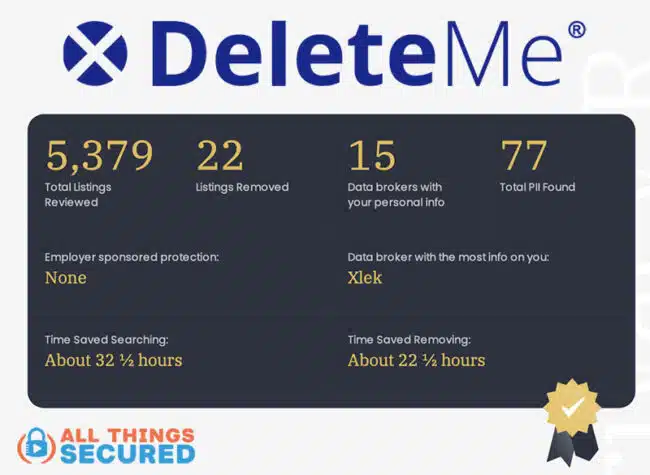
In the example above, you can see that personal data was found on 15 different data brokers and more than 70 pieces of PII were found and removed. Search results no longer show this person’s data.
Get 20% Off DeleteMe
Use the exclusive code “ATS” at checkout to get 20% off any subscription with DeleteMe.
Step 3: Find & Delete Old Accounts
Remember that old MySpace account you created a decade ago? Or perhaps that Twitter account that you no longer use? When you consider how to hide digital footprint, these things matter.
All of these old social media profiles and online services leave behind an unnecessary trace of your digital footprint on the internet. One of the best ways to find an old online account is to look through your email to see which companies are sending you marketing messages.
If you don’t actively use their service, log in and request that your account be deleted or locked down.
Step 4: Delete Previous Negative Comments & Reviews
Leaving a negative comment or review may feel good in the moment, but it usually only serves to hurt your online reputation.
In this case, you can try the following:
- Facebook: It’s hard to find all of your old comments, but look through the posts and delete anything that you wouldn’t want your mother to read.
- Amazon: You can look at all the reviews you’ve left and make sure that it’s still an accurate reflection of your feelings now that you’ve had more time to process.
- Twitter: Go through your archive and delete any tweets that are no longer a good reflection of what you represent.
Step 5: Do a Mobile Device Audit
Do an audit of the apps you keep on your mobile phone. Do you still use them? Are they absolutely necessary?
If not…delete it!
For those who want to know how to wipe your internet footprint, it’s becoming more and more important to start with your mobile device.
Moving Forward with Privacy
Once you feel comfortable with how you’ve dealt with your digital footprint protection and online accounts, it’s time to start thinking about how you’re going to take much more care with your data moving forward.
In the digital world, ignorance is your worst enemy.
Internet users, through their daily activities online, may unknowingly allow cybercriminals to gain access to their personal information. It’s crucial for every internet user to understand the importance of adjusting privacy settings and practicing cautious online behavior to safeguard against such vulnerabilities. This awareness and proactive stance are essential in preventing unauthorized access to sensitive information.
How can you limit the risk of your digital footprint moving forward?
- Change Your Privacy Settings: Whether it’s your social media account or your internet browser, find the privacy settings and make sure they reflect how you want to be tracked.
- Use Aliases: As much as you can, try not to give out your actual information. Instead of your primary email address, use an alias. Instead of your personal mobile number, use a virtual phone number.
- Monitor Your Data: You can monitor your credit by checking your credit report with each of the credit bureaus. Or you can pay for a service to do it for you. Either way, monitoring your data is essential.
- Use a Privacy-Centric Internet Browser: Try to find a good Chrome alternative that will respect your privacy as you browser the internet on your computer or mobile device.
- Be Positive! There are times when you need to offer criticism online, but the more you can create a positive digital footprint, the better.

